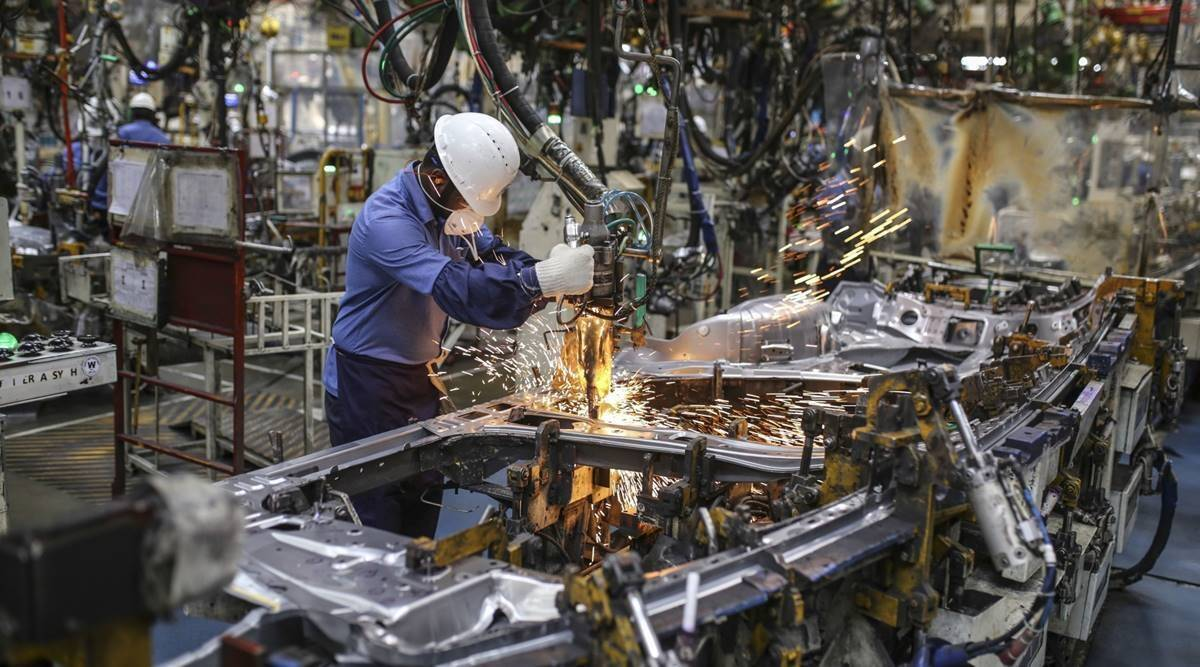Description

Copyright infringement not intended
Context: The May Purchasing Managers’ Index (PMI) showed that India’s gross domestic product (GDP) expanded at 6.1 per cent January-March 2023 quarter, in turn pushing up the growth estimate for the full year 2022-23 to 7.2 per cent. The manufacturing sector registered a year-on-year growth of 4.5 per cent in Q4 FY2023.
Details
- The manufacturing sector is a vital component of India's economy, contributing about 15% of the country's GDP and employing over 100 million people. The performance of the sector is closely monitored by various indicators, such as the Purchasing Managers' Index (PMI), which measures the activity level of purchasing managers in the manufacturing industry.
- The PMI is based on a monthly survey of around 400 manufacturing companies, covering aspects such as new orders, production, employment, inventories, prices, exports and imports. A PMI reading above 50 indicates an expansion in manufacturing activity compared to the previous month, while a reading below 50 signals a contraction.
PMI May 2023
- In May 2023, India's manufacturing PMI rose to a 31-month high of 58.7 (it was 57.2 in April), indicating a strong improvement in the health of the sector since October 2020. This was driven by a surge in domestic and foreign demand for Indian-made products, which boosted factory orders, production, employment and input purchasing.
- The PMI also showed that supply chain conditions improved further, leading to a record increase in input stocks. Moreover, cost pressures remained historically mild, while output prices increased at a solid and faster pace.
What are the factors behind the PMI rise in May?
- One of the main reasons for the rise in India's manufacturing PMI in May was the remarkable strength in demand conditions.
- According to S&P Global Market Intelligence Economics Associate Director Pollyanna De Lima, "The PMI’s spotlight on soaring sales showcases robust demand for Indian-made products both domestically and internationally."
GDP Growth
- The Indian economy has shown remarkable resilience and recovery in the face of the global pandemic and its challenges. According to the latest data released by the National Statistical Office (NSO), India's gross domestic product (GDP) grew by 6.1 per cent in the January-March 2023 quarter, the fourth quarter of the fiscal year 2022-23.
- This was higher than the median estimate of 5.1 per cent by a poll of 20 economists. For the full year 2022-23, India's GDP growth is estimated at 7.2 per cent, making it one of the fastest-growing major economies in the world.
Manufacturing
- One of the key drivers of this impressive performance was the manufacturing sector, which registered a year-on-year growth of 4.5 per cent in Q4 FY2023.
- The manufacturing sector benefited from a surge in exports, which grew by 28.8 per cent in FY22 and 18.9 per cent in the first half of FY23.
Factory orders
- Factory orders increased for the twenty-third consecutive month in May and at the fastest rate since January 2021. This was supported by advertising, a favourable economic climate and strong customer demand.
- Exports also contributed to the growth of new orders, as international sales expanded at the quickest pace for six months.
- The growth of new orders also encouraged manufacturers to increase their input purchasing in May. Quantities of purchases rose at the sharpest rate in over 12 years, as firms sought to replenish their stocks and prepare for future demand.
Rising demand
- The surge in sales led to higher production levels, as manufacturers ramped up their output to meet the rising demand. Production increased for the twenty-fourth month running in May and at a faster rate than in April.
Increase employment
- Another factor that boosted the PMI in May was the increase in employment. As production requirements rose, manufacturers hired more workers to cope with the higher workload. Employment increased for the fourth successive month in May and at a quicker pace than in April.
Improvement in the supply chain
- The improvement in supply chain conditions also helped manufacturers to accumulate inputs at an unprecedented rate. Stocks of purchases rose for the third month running in May and at a record pace.
- This indicated that manufacturers were better prepared to manage potential disruptions and maintain a steady flow of production.
Private Consumption
- Private consumption, which accounted for 58.4 per cent of GDP in Q2 FY23, is the highest among the second quarters of all the years since 2013-14.
- Private consumption was supported by a recovery in contact-intensive services such as trade, hotel and transport, which were severely affected by the lockdowns and social distancing measures imposed during the pandemic.
Others
- The near-universal vaccination coverage enabled people to resume their normal activities and spend on these services.
- The return of migrant workers to construction activities also helped the housing market witnessed a significant decline in inventory overhang to 33 months in Q3 FY23 from 42 months last year.
Government role
- The government also played a crucial role in boosting the economy by increasing its capital expenditure (Capex) by 63.4% in the first eight months of FY23.
- The Capex was mainly directed towards infrastructure development, which has a high multiplier effect on growth and employment.
- The government also announced several stimulus measures to support various sectors and segments of society affected by the pandemic. These included direct cash transfers, free food grains, credit guarantees, tax relief, liquidity infusion, and sector-specific schemes.

What are the implications of the PMI rise in May?
- The rise in India's manufacturing PMI in May has several positive implications for the economy and the industry.
Expansion in manufacturing activity
- It shows that the manufacturing sector is recovering strongly from the impact of the COVID-19 pandemic, which caused a severe contraction in activity last year. The PMI has remained above 50 for eleven consecutive months since July 2022, indicating a sustained expansion in manufacturing activity.
- It suggests that the manufacturing sector is contributing significantly to India's economic growth, which has rebounded from a historic low of -7.3% in 2020-21 to an estimated 7.2% in 2022-23. The manufacturing sector registered a year-on-year growth of 4.5% in Q4 FY2023.
Creating more jobs and income opportunities
- It indicates that the manufacturing sector is creating more jobs and income opportunities for millions of people. The increase in employment and output prices reflects that manufacturers are confident about their business prospects and are willing to invest in human and physical capital.
Global Supply Chain
- It signals that India's manufacturing sector is becoming more competitive and resilient in the global market. The growth of exports shows that Indian products are meeting the quality and price expectations of foreign customers. The record accumulation of input stocks shows that manufacturers are better prepared to deal with supply chain challenges and demonstrate their reliability.
Outlook for the Indian economy in FY24
- The outlook for the Indian economy in FY24 is optimistic, with a baseline GDP growth projection of 6.5 per cent in real terms by the Economic Survey 2022-23. The survey expects a vigorous credit disbursal and capital investment cycle to unfold in India with the strengthening of the balance sheets of the corporate and banking sectors.
- The survey also points to some risks and challenges that may affect the growth prospects, such as high inflation, global trade uncertainties, geopolitical tensions, environmental shocks, and new variants of Covid-19.
- The survey suggests that India needs to continue its reform agenda and focus on enhancing productivity, competitiveness, innovation, and social welfare to achieve its potential growth trajectory.
Summary
- India's manufacturing PMI hit a 31-month high in May 2023, reflecting a strong improvement in the health of the sector since October 2020. The rise was driven by robust demand for Indian-made products both domestically and internationally, which boosted factory orders, production, employment and input purchasing.
- The PMI also showed that supply chain conditions improved further, leading to a record increase in input stocks. Moreover, cost pressures remained historically mild, while output prices increased at a solid and faster pace.
- The rise in India's manufacturing PMI has several positive implications for the economy and the industry. It shows that the manufacturing sector is recovering strongly from the impact of the COVID-19 pandemic; contributing significantly to India's economic growth; creating more jobs and income opportunities; and becoming more competitive and resilient in the global market.
Must Read Articles:
India’s Manufacturing Sector and PMI: https://www.iasgyan.in/daily-current-affairs/indias-manufacturing-sector-and-pmi
Making India a Manufacturing Hub: https://www.iasgyan.in/ig-uploads/pdf/RSTV_-_Making_India_a_Manufacturing_Hub_Reviewed.pdf
|
PRACTICE QUESTION
Q. India is one of the fastest-growing economies in the world, and manufacturing is a key sector that contributes to its growth and development. However, the manufacturing sector in India faces many challenges. How can India overcome these challenges and enhance its manufacturing competitiveness? What are the benefits of developing a strong manufacturing base for India's economy and society?
|

https://indianexpress.com/article/explained/explained-economics/why-indias-manufacturing-pmi-hit-31-month-high-may-8642059/














